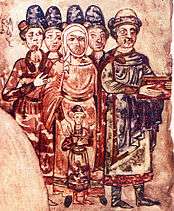Constantine of Murom

Constantine of Murom (Russian: Святой Блаженный Князь Константин) (? - 1129) was a direct descendant of Vladimir I of Kiev and the son of Prince Svyatoslav of Chernigov.
Life
At Constantine's request, his father assigned him to rule the city of Murom, which at the time was inhabited by pagans, that he might spread Christianity in that region. According to the traditional account of his life, Constantine first sent his son Michael to Murom as his emissary, but the inhabitants threw him from the walls, so Constantine was obliged to take the city by force.[1] However, he made no headway in converting them to Christianity and at one point they became so angry that a mob made their way to his fortress intending to storm the place. According to legend, when he appeared before them bearing what is now known as the Murom-Ryazan icon of the Theotokos, they quieted down and bowed reverently before the holy image.[2] His son Fyodor, with his support, continued the missionary work in the surrounding countryside.
He is commemorated in the Russian Orthodox Church on May 21.[3] His wife Irene is also venerated at Murom.[1]
The richly decorated Cathedral of the Annunciation was reportedly founded by Prince Constantinin in 1205. It became a monastery under Ivan the Terrible and was ruined by the Poles during the Time of Troubles. In 1664 it was rebuilt by wealthy merchant and arts patron Tarasy Tsvetnov. The monastery features the relics of Constantin and his sons Mikhail and Fyodor. According to a legend recorded by local aristocrat and amateur historian Alexander Yepanchin, each midnight the monastery's gates disappear, and Constantine, Mikhail and Fyodor, clad in regal attire, ride out in a gilded carriage and head to the Cathedral of the Nativity of Mary, where they are met by Pyotr and Fevronia. After praying there, they guard and patrol the city.[4]
Mother of God, "The Star Most Bright"

The icon shows a full-length representation of the Mother of God with a star sending forth rays of light in the background. The origin of its name is connected with the poetic hymns in honor of the Most Holy Theotokos. Standing on Her right hand is the Infant Jesus. At Her feet are Murom saints: Sts Constantine, Mikhail and Fyodor arrayed in princely robes and Sts Petr, Fevronia and Uliania clad in monastic habits. In the bottom part of the icon is the following inscription: 'This Marvelous Image Is the Star Most Bright of the Most Holy Lady Mother of God Queen of Heaven."[5]
References
- 1 2 Walsh, Michael J., "Constantine of Murom", A New Dictionary of Saints: East and West, Liturgical Press, 2007 ISBN 9780814631867
- ↑ Murom-Ryazan icon of the Mother of God
- ↑ (Greek) Οἱ Ἅγιοι Κωνσταντίνος, Μιχαὴλ καὶ Θεόδωρος οἱ Πρίγκιπες καὶ Θαυματουργοί. 21 Μαΐου. ΜΕΓΑΣ ΣΥΝΑΞΑΡΙΣΤΗΣ.
- ↑ Sukhov, Oleg, "Murom: Murom Still Lives in a Fairy Tale", The Moscow Times, November 25, 2012
- ↑ Icon of Mother of God "The Star Most Bright"
Sources
- A reference in Russian Orthodox Calendar
- Life of the saint from the website of the Orthodox Church in America.